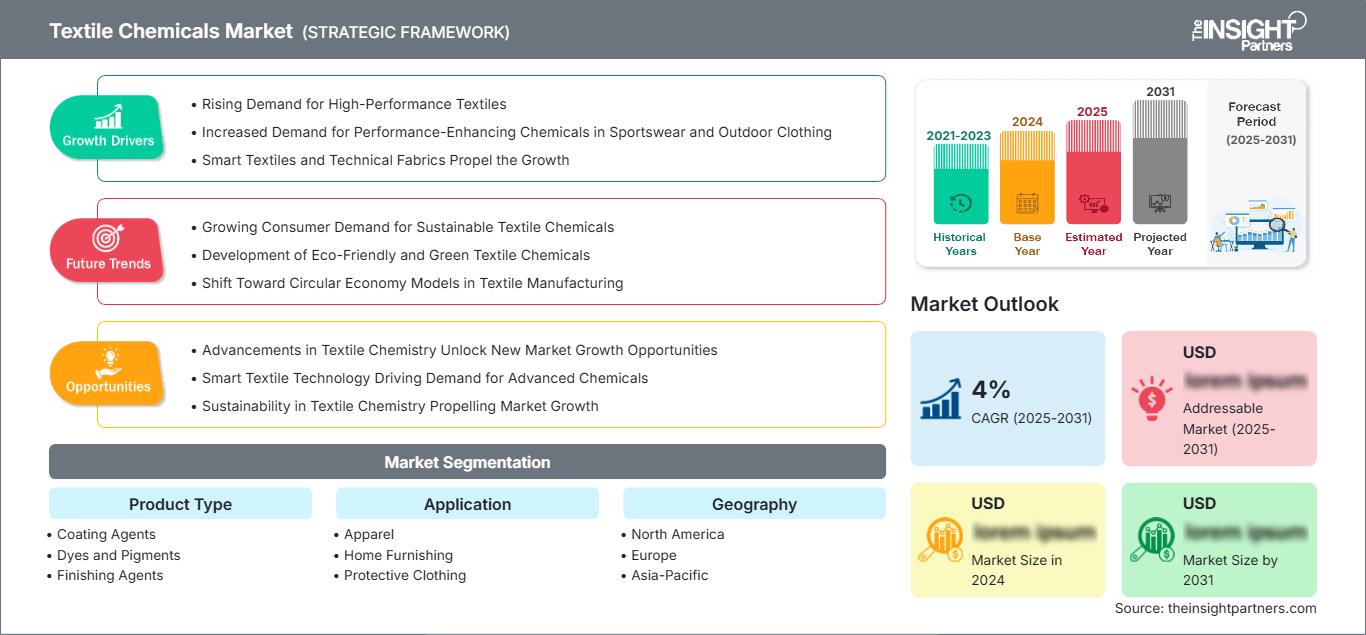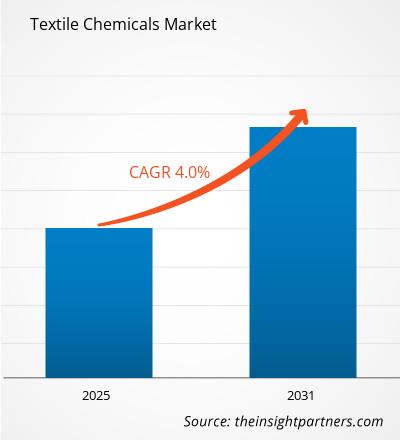Si prevede che il mercato dei prodotti chimici tessili raggiungerà i 36,59 miliardi di dollari entro il 2031. Si prevede che il mercato registrerà un CAGR del 4,6% nel periodo 2025-2031.
Il rapporto presenta un'analisi basata sulla tipologia di prodotto (agenti di rivestimento, coloranti e pigmenti, agenti di finitura, tensioattivi, agenti di sbozzimatura e altri). Il rapporto è segmentato per applicazione (abbigliamento, arredamento per la casa, indumenti protettivi e altri). L'analisi globale è ulteriormente suddivisa a livello regionale e per i principali paesi. Le dimensioni del mercato e le previsioni a livello globale, regionale e nazionale per tutti i principali segmenti di mercato sono trattate nell'ambito di applicazione. Il rapporto fornisce il valore in dollari USA per l'analisi e i segmenti sopra indicati. Il rapporto fornisce statistiche chiave sullo stato del mercato dei principali attori e offre tendenze e opportunità di mercato.
Scopo del rapporto
Il rapporto "Textile Chemicals Market" di The Insight Partners mira a descrivere il panorama attuale e la crescita futura, i principali fattori trainanti, le sfide e le opportunità. Ciò fornirà spunti a vari stakeholder aziendali, come:
- Fornitori/produttori di tecnologia: per comprendere le dinamiche di mercato in evoluzione e conoscere le potenziali opportunità di crescita, consentendo loro di prendere decisioni strategiche informate.
- Investitori: per condurre un'analisi completa delle tendenze in merito al tasso di crescita del mercato, alle proiezioni finanziarie del mercato e alle opportunità esistenti lungo la catena del valore.
- Organismi di regolamentazione: per regolamentare le politiche e le attività di controllo nel mercato con l'obiettivo di ridurre al minimo gli abusi, preservare la fiducia degli investitori e sostenere l'integrità e la stabilità del mercato.
Segmentazione del mercato dei prodotti chimici tessili Tipo di prodotto
- Agenti di rivestimento
- Coloranti e pigmenti
- Agenti di finitura
- Tensioattivi
- Agenti di sbozzimatura
Applicazione
- Abbigliamento
- Arredamento per la casa
- Indumenti protettivi
Potrai personalizzare gratuitamente qualsiasi rapporto, comprese parti di questo rapporto, o analisi a livello di paese, pacchetto dati Excel, oltre a usufruire di grandi offerte e sconti per start-up e università
Mercato dei prodotti chimici tessili: Approfondimenti strategici

-
Ottieni le principali tendenze chiave del mercato di questo rapporto.Questo campione GRATUITO includerà l'analisi dei dati, che vanno dalle tendenze di mercato alle stime e alle previsioni.
Fattori di crescita del mercato dei prodotti chimici tessili
- Crescente domanda di tessuti ad alte prestazioni: la crescente domanda di tessuti ad alte prestazioni è uno dei principali fattori che guidano la crescita di questo mercato dei prodotti chimici tessili. Esistono diversi tipi di settori che richiedono trattamenti chimici specializzati su tessuti ad alte prestazioni per migliorarne la durata, l'assorbimento dell'umidità, la resistenza alla fiamma e così via. Pertanto, i prodotti chimici tessili avanzati sono molto richiesti.
- Crescente domanda di prodotti chimici che migliorano le prestazioni nell'abbigliamento sportivo e outdoor: poiché le industrie tessili cercano prodotti più funzionali, aumenta la domanda di prodotti chimici che offrano prestazioni migliori. Ad esempio, i prodotti chimici che migliorano la resistenza, l'elasticità e la resistenza ai raggi UV dei tessuti trovano importanti applicazioni nell'abbigliamento sportivo e outdoor. Questo è uno dei fattori alla base della crescita del mercato dei prodotti chimici tessili, poiché i produttori stanno investendo in nuove soluzioni chimiche.
- Tessuti intelligenti e tessuti tecnici stimolano la crescita: i tessuti intelligenti e i tessuti tecnici che contengono sensori o materiali conduttivi sono un settore emergente. Tali tessuti richiedono prodotti chimici per i complessi processi di produzione a cui sono sottoposti, senza compromettere la funzionalità dell'elettronica integrata. Con una crescente base di applicazioni per i tessuti intelligenti, il mercato dei prodotti chimici tessili è in rapida crescita grazie a prodotti speciali.
Tendenze future del mercato dei prodotti chimici tessili
- Crescente domanda dei consumatori di prodotti chimici tessili sostenibili: la crescente preferenza dei consumatori per i prodotti sostenibili è una delle tendenze future più significative che guideranno la crescita del mercato dei prodotti chimici tessili. I consumatori, sempre più attenti all'ambiente, tendono a richiedere tessuti più rispettosi dell'ambiente. Questa tendenza ha spinto i produttori ad adottare prodotti chimici tessili sostenibili che riducano al minimo l'impatto ambientale mantenendo al contempo standard di alta qualità.
- Sviluppo di prodotti chimici tessili ecologici e rispettosi dell'ambiente: lo sviluppo di prodotti chimici ecologici, come coloranti biodegradabili, finiture a base d'acqua e trattamenti ecocompatibili nei tessuti, ha un impatto significativamente positivo sulle emissioni, sul consumo di acqua e sui livelli di rifiuti tossici prodotti durante la produzione, soddisfacendo sia le aspettative normative che quelle dei consumatori. Ciò dà impulso alla crescita del mercato, poiché i produttori si stanno orientando verso alternative più ecologiche.
- Passaggio a modelli di economia circolare nella produzione tessile: la maggiore pressione sulle industrie della moda e del tessile è quella di operare attraverso modelli di economia circolare in cui i prodotti vengono riciclati anziché essere gettati via, e i prodotti chimici tessili che non danneggiano il processo di riciclabilità dei tessuti sono considerati altamente considerati. Il mercato dei prodotti chimici tessili si sta già evolvendo per offrire soluzioni che mettono al centro la sostenibilità.
Opportunità di mercato per i prodotti chimici tessili
- I progressi nella chimica tessile aprono nuove opportunità di crescita del mercato: il mercato dei prodotti chimici tessili è aperto a enormi opportunità di crescita, grazie ai progressi nella chimica tessile. Nuove formulazioni e processi, ad esempio, consentirebbero la produzione di prodotti ad alte prestazioni e più efficaci; inoltre, vi è la necessità di prodotti chimici specializzati per rispondere alla crescente esigenza di caratteristiche di durabilità, gestione dell'umidità o protezione dai raggi UV nei tessuti.
- La tecnologia tessile intelligente stimola la domanda di prodotti chimici avanzati: inoltre, l'introduzione della tecnologia intelligente nei tessuti sta stimolando la domanda di prodotti chimici avanzati per i tessuti intelligenti. In altre parole, i tessuti intelligenti progettati per incorporare materiali conduttivi o sensori necessiteranno di prodotti chimici per il loro corretto funzionamento. Poiché l'applicazione si sta diffondendo in ambito sanitario, elettronico e dell'abbigliamento sportivo, la crescita dei prodotti chimici tessili potrebbe essere migliorata.
- La sostenibilità nella chimica tessile stimola la crescita del mercato: anche i progressi nella chimica tessile sostenibile svolgono un ruolo di primo piano nella crescita del mercato. Prodotti chimici ecocompatibili e biodegradabili, come coloranti a base d'acqua e finiture atossiche, vengono sviluppati per favorire la transizione del settore verso processi di produzione più ecologici. Pertanto, i prodotti chimici tessili ecocompatibili stanno guadagnando terreno. I consumatori sono sempre più alla ricerca di prodotti ecocompatibili, mentre la legislazione ambientale sta diventando più severa.
Mercato dei prodotti chimici tessili
Le tendenze regionali e i fattori che influenzano il mercato dei prodotti chimici tessili durante il periodo di previsione sono stati ampiamente spiegati dagli analisti di The Insight Partners. Questa sezione illustra anche i segmenti di mercato e la geografia della gestione delle malattie del ritmo cardiaco in Nord America, Europa, Asia-Pacifico, Medio Oriente e Africa, America meridionale e centrale.
Ambito del rapporto sul mercato dei prodotti chimici tessili
| Attributo del rapporto | Dettagli |
|---|---|
| Dimensioni del mercato in 2024 | US$ XX Billion |
| Dimensioni del mercato per 2031 | US$ 36.59 Billion |
| CAGR globale (2025 - 2031) | 4.6% |
| Dati storici | 2021-2023 |
| Periodo di previsione | 2025-2031 |
| Segmenti coperti |
By Tipo di prodotto
|
| Regioni e paesi coperti |
Nord America
|
| Leader di mercato e profili aziendali chiave |
|
Densità degli attori del mercato dei prodotti chimici tessili: comprendere il suo impatto sulle dinamiche aziendali
Il mercato dei prodotti chimici tessili è in rapida crescita, trainato dalla crescente domanda degli utenti finali, dovuta a fattori quali l'evoluzione delle preferenze dei consumatori, i progressi tecnologici e una maggiore consapevolezza dei benefici del prodotto. Con l'aumento della domanda, le aziende stanno ampliando la propria offerta, innovando per soddisfare le esigenze dei consumatori e sfruttando le tendenze emergenti, alimentando ulteriormente la crescita del mercato.

- Ottieni il Mercato dei prodotti chimici tessili Panoramica dei principali attori chiave
Punti di forza
- Copertura completa: il rapporto analizza in modo esaustivo prodotti, servizi, tipologie e utenti finali del mercato dei prodotti chimici tessili, offrendo una panoramica olistica.
- Analisi degli esperti: il rapporto è redatto sulla base della conoscenza approfondita di esperti e analisti del settore.
- Informazioni aggiornate: il rapporto garantisce la pertinenza aziendale grazie alla copertura di informazioni e dati recenti.
- Opzioni di personalizzazione: questo rapporto può essere personalizzato per soddisfare le esigenze specifiche del cliente e adattarsi in modo appropriato alle strategie aziendali.
Il rapporto di ricerca sul mercato dei prodotti chimici tessili può quindi contribuire a guidare il percorso di decodificazione e comprensione dello scenario del settore e delle prospettive di crescita. Sebbene possano esserci alcune valide preoccupazioni, i vantaggi complessivi di questo rapporto tendono a superare gli svantaggi.
- Analisi storica (2 anni), anno base, previsione (7 anni) con CAGR
- Analisi PEST e SWOT
- Valore/volume delle dimensioni del mercato - Globale, Regionale, Nazionale
- Industria e panorama competitivo
- Set di dati Excel
Report recenti
Rapporti correlati
Testimonianze
Motivo dell'acquisto
- Processo decisionale informato
- Comprensione delle dinamiche di mercato
- Analisi competitiva
- Analisi dei clienti
- Previsioni di mercato
- Mitigazione del rischio
- Pianificazione strategica
- Giustificazione degli investimenti
- Identificazione dei mercati emergenti
- Miglioramento delle strategie di marketing
- Aumento dell'efficienza operativa
- Allineamento alle tendenze normative






















 Ottieni un campione gratuito per - Mercato dei prodotti chimici tessili
Ottieni un campione gratuito per - Mercato dei prodotti chimici tessili